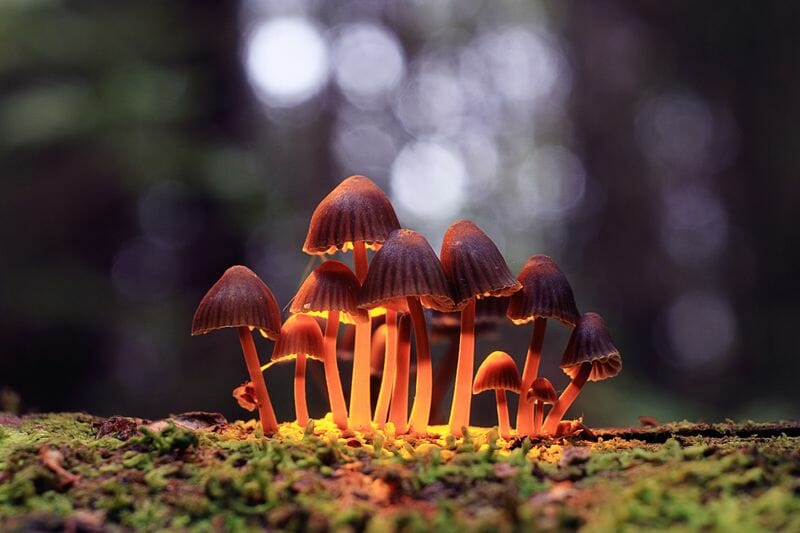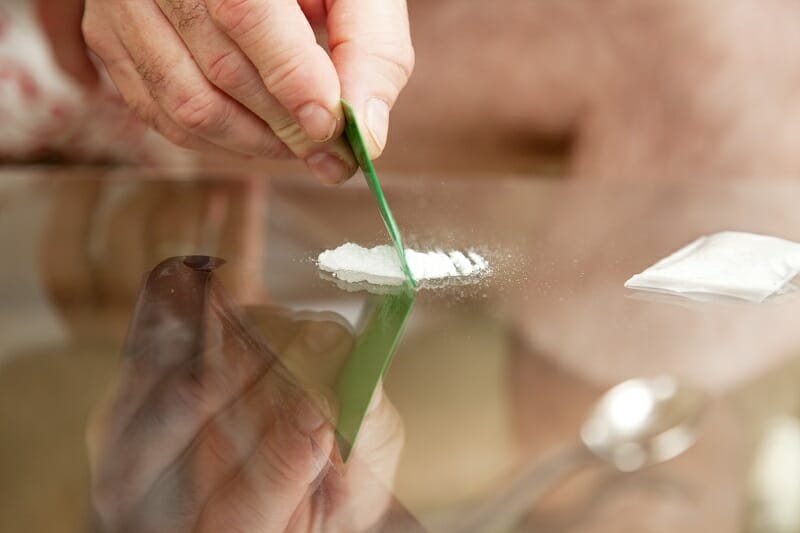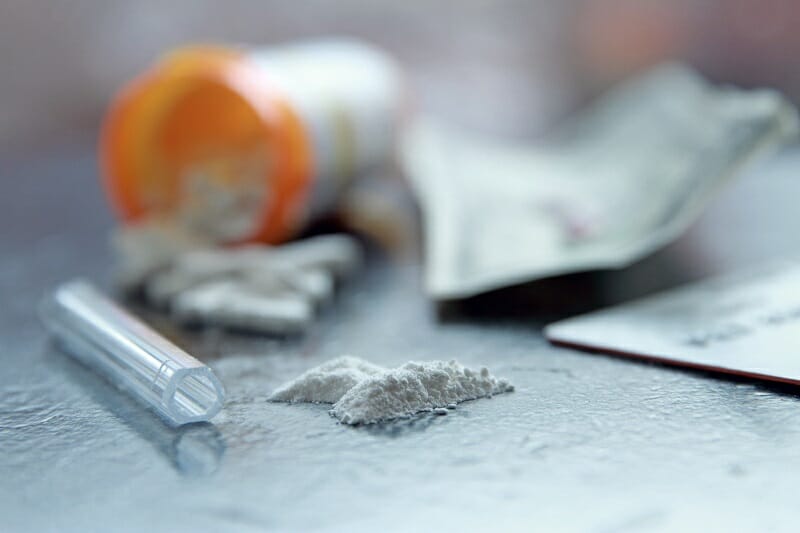DMT Addiction Explained
What Kind of Drug Is DMT?
Known by some as “the spirit molecule”, and consumed in spiritual and mystical ceremonies in the New World for at least 1,000 years, DMT is found in many plants and animals. Yet, its abuse poses significant psychological dangers. As the availability of DMT grows thanks to the dark web, more and more people in the UK and elsewhere are coming to contact with the drug and its attendant risks.

What is dimethyltryptamine (DMT)?
DMT – sometimes known by its full chemical name N,N-Dimethyltryptamine – is a naturally occurring chemical. It is an alkaloid derived from an amino acid L-tryptophan. It is found in the brains and bodies of various plants and animals, with some experts positing that it may be present in most multicellular life. DMT has an extremely powerful psychedelic and hallucinogenic properties when consumed. In some cases, these prompt visions, which many users describe as featuring external entities such as spirits or aliens.
Some studies suggest that DMT may be found in most if not all animals including humans (in particular, in the pineal gland in the brain). However, the integrity and accuracy of these tests have been questioned and there is currently no scientific consensus regarding how widely DMT is found in the natural world.
DMT is present in a number of traditional spiritual and ceremonial medicines, including ayahuasca, which have been consumed for many centuries by indigenous tribes in parts of South America, and which have played a significant role in the development of their cultures and the shamanic tradition.
DMT is commonly found in a crystalline form, with crystals ranging from white (very pure) to yellowish brown (increasingly impure). Only a very small dose is required to produce very intense visual and auditory hallucinations, with a short duration of action compared with other more famous hallucinogens – between five and 15 minutes when smoked.
Call our admissions line 24 hours a day to get help.
Understanding DMT
Partly because of the heavily politicised environment regarding substances of abuse, research into DMT is comparatively limited. However, some studies have been carried out into its effects on humans;slightly more substantially into how it affects animals.
The fact that it has been found in several mammals, including rats and rabbits, as well as in a number of plants suggests that DMT may be relatively common if not ubiquitous in multicellular life, though more research is needed to confirm such theories.
In the human brain, DMT binds with numerous different receptors including those relating to serotonin, dopamine and other neurochemicals associated with euphoria and hallucinations. However, the precise mechanisms by which DMT produces its extraordinary effects are not yet fully understood. It is thought, however, that much of the psychedelic impact of DMT results from its functionally selective activation of the 5-HT2A serotonin receptor; also affected by numerous other hallucinogens.
However, the powerful psychoactive qualities of DMT can give rise to distressing and even terrifying experiences with potentially very serious negative consequences for those users affected by them. As with any other hallucinogen, DMT has the potential to be psychologically addictive with profound ramifications for those caught up in addiction.
DMT itself is a functional and structural analogue of several other psychedelic tryptamines, including 4-AcO-DMT, 5-MeO-DMT, 5-HO-DMT, psilocin and psilocybin. These chemicals are sometimes sold as “DMT”. While their effects are often very similar, they are not identical substances and may pose the risk of different, potentially dangerous side effects.
Is DMT a hallucinogen or a sedative?
Although DMT can have sedative effects on some users, it is not typically considered to be a sedative. It is certainly not used as such in a medical environment. It is, however, strongly hallucinogenic and this is the basis on which DMT is typically treated both legally and in research settings.
What is ayahuasca?
Ayahuasca is the name for an entheogenic brew made out of the vine Banisteriopsis caapi alongside any of various other ingredients.Entheogenic –a class of substances used to induce psychological and spiritual experiences and personal development, as opposed to for poorly recreational purposes. It is used as a traditional spiritual and ceremonial medicine amongst some of the indigenous peoples of Amazonia and elsewhere in South America.
Consuming ayahuasca in ceremonial circumstances involves the performance of certain rituals – differing from one tribe to another – both prior to, during and after the consumption of the brew and the experience of its effects. In recent years, ayahuasca has become increasingly available in parts of the West, but those responsible for its proliferation and use typically adhere to at least some of the ceremonies which accompany its consumption in its territories of origin.
Upon drinking ayahuasca, its effects begin to take hold after between half an hour to an hour and can last twelve hours or more depending on the dosage. During that time, users may experience radically altered states of consciousness, sometimes described as being a “dream state”, during which they may have visions and spiritual revelations which many consider to be profoundly life-changing.
The experience of taking ayahuasca can be overwhelming and can cause significant including extreme panic, alongside a host of physiological symptoms possibly including nausea, vomiting, diarrhoea, tremors, hyperthermia, muscle spasms, dizziness and impaired motor function. Ayahuasca consumption has been linked with a number of deaths, though it is unclear whether or not it has been the primary cause of these fatalities or if other factors have been more significant.
Because of the mystique in which ayahuasca use has traditionally been shrouded, and its relatively recent arrival in the developed world, scientific research into its properties and long-term effects is comparatively limited. It is not yet known whether or not ayahuasca abuse poses significant dangers beyond the temporary negative side-effects mentioned.
A brief history of DMT
The use of ayahuasca, containing DMT, dates back to at least 1,000 years ago when, combined with other shamanic items, the plant was already being used. Following the Spanish conquest of much of the New World in the 15th and 16th centuries, missionaries reported the use of ayahuasca by indigenous tribes in the Amazonian basin.
In the modern age, DMT was first synthesised in 1931, but its discovery as a natural product is usually credited to Oswaldo Goncalves de Lima, a Brazilian chemist who isolated an alkaloid from the root of the plant Mimosa tenuiflora.
From the 1950s onwards DMT began to be studied scientifically in the developed world, including in human experimentation. The early phases of the “counterculture” of the 1960s saw a period of intense experimentation with psychoactive substances, typically in underground scientific, artistic and philosophical circles. DMT’s potency and ability to create radically altered states of consciousness,saw it gain an immediate and imposing reputation.
In 1965, influential ethnobotanist Terence McKennadescribed encounters he had purportedly had whilst on DMT with a form of hyperdimensional beings he called “machine elves” (also “fractal elves” and “self-transforming machine elves”). Some scientists believe that this phenomenon could be of great significance for our understanding of our place in the cosmos and the true nature of the universe, and campaign for more research into DMT and the liberalisation of the legislative framework surrounding its use.
In 1971 the United Nations included DMT in its list of banned psychotropic drugs. The UK’s Misuse of Drugs Act 1971 places DMT in the same category (class A) as heroin and cocaine. Currently, the advent of the internet (and the dark web in particular) has seen both awareness of DMT, and access to it, proliferate in the UK. It is now thought to be consumed in this country in greater quantities than at any time previously.
Call our admissions line 24 hours a day to get help.
Routes of administration
DMT is usually smoked, typically through a pipe. However, it can be put into cigarettes or “joints” but users typically prefer to take one big “hit” of the drug and then hold that breath for as long as possible, for which cigarettes are far from ideal. It can also be snorted or injected, though this means of administration is extremely rare. As an ingredient in other substances, such as ayahuasca, DMT can also be swallowed.
Immediate effects of DMT use
Upon taking DMT, the user almost immediately becomes aware of a noticeable and growing distortion of their visual and auditory perception. Colours become significantly more intense; light and shadow become more pronounced, while sound can become distorted in pitch, tone and volume. Very rapidly, these developments evolve into intense hallucinations, potentially including the perception of unreal things and dizzying changes to what is seen and heard. At the same time, although the user may not be conscious of these developments, they may undergo numerous physiological changes including raised blood pressure and heart rate, fluctuating body temperature and dilated pupils.
DMT Street Names
DMT’s comparatively recent arrival on the UK recreational scene, and relative inaccessibility means that it is usually referred to simply as “DMT”. However, a number of street names for the drug have been reported, including:
- D
- Dimitri
- businessman’s trip
- businessman’s special
- fantasia
- forty-five-minute psychosis
- Foxy
- Foxy Methoxy
DMT Abuse and What Draws People to This Hallucinogenic Drug
People are typically drawn to hallucinogens by the desire to experience altered states, which can provide simple enjoyment as well as more profound experiences. However, because of the mystique associated with DMT and the various reports of its powerful nature, some people who are content to take other hallucinogens, shy away from DMT itself. It is often seen as the “hardest” or “most powerful” hallucinogen, and therefore the one that poses the greatest risk of a “bad trip”.

DMT is also sometimes taken in conjunction with other psychedelics, or “rave drug” stimulants, such as ecstasy
(MDMA) in environments such as parties festivals, where polydrug use is not uncommon. These users may be less interested in the standalone effects of DMT, considering them more a part of a “drug cocktail” contributing to the overall experience of their environment.
DMT Counterculture
DMT has traditionally been associated with countercultural trends and thinkers, including some of the most renowned personalities of the “flower power” era. Its powerful effects can create perspectives on life which may be unattainable by most people without psychedelic assistance. While for many people this dislocation from normal life can be terrifying and a powerful disincentive for DMT use, for others, dissatisfied with the governing ideologies and social norms of modern life DMT can seem a perfect vessel for experiencing “deeper truth” and spiritual awakening.
How to Recognise DMT Abuse and Addiction
Addiction is a disorder of the brain’s reward system in which the affected individual is compelled to engage repeatedly in particular behaviours despite an awareness of the negative consequences of doing so. The exposure to rewarding stimuli – in this case, taking DMT and experiencing its effects – can cause an adjustment to the activity of reward centres in the brain. This includes the production of increased quantities of chemicals such as dopamine (associated with feelings of pleasure, wellbeing and reward) when the behaviour in question is repeated. Thus, it drives further instances of that behaviour. Similarly, when the behaviour is avoided, lower levels of dopamine can cause negative sensations and emotions, such as low mood, which the individual may attempt to drive off by further engagement in the addictive behaviour.
Because of its direct effects upon dopamine receptors in the brain, this drug can compel users to want to repeat the experience over and over again. Thus, reinforcing the development of addictive behavioural patterns and the adjustment of the brain’s reward system which can result.
Some substances of abuse are not only psychologically addictive but pose the risk of physical dependence. This is when the brain and body of the user become reliant upon the presence of the substance in question to perform their normal functions, with physical withdrawal symptoms potentially manifesting upon cessation of use. Like most hallucinogens, DMT is not known to be physically addictive However, the lack of research into its long-term effects means that such an eventuality should not be discounted completely.
While it may be impossible to identify the presence of addiction even in someone close to you (addicts typically go to significant lengths to hide their condition), some signs of DMT abuse and addiction may include:
- frequent obvious intoxication potentially including bizarre behaviour, incoherent speech, or heavy sedation
- burn marks on fingers or lips
- possessing paraphernalia including pipes and drug “baggies”
- a growing interest in psychedelics and the counterculture
- changed vocabulary
- new peer group
- lack of care regarding hygiene or appearance
- financial difficulties
- alienation and isolation
- describing experiences which may sound very strange to non-users
- altered sleeping and eating patterns
- paranoia
- psychosis
- depression
- anxiety
- a loss of interest in previously enjoyed activities
- impaired professional and/or academic performance
- neglect of responsibilities
- growing distant from family and friends
- changed outlook on the world
- altered personal philosophy or ideology
The Effects and Risks of DMT
DMT is not considered especially physically dangerous and does not have a recognised physical dependence liability. Most of the negative consequences and risks associated with DMT are psychological in nature. Some reports claim that DMT can cause respiratory arrest, coma and potentially death, though it is not certain whether DMT itself has been responsible for those effects or whether they have resulted from the simultaneous effects of other substances of abuse or health conditions.
Call our admissions line 24 hours a day to get help.
Short-term side effects of DMT use
Some users report feelings of intense fear, anxiety and panic both during and after their DMT “trips”, along with disturbing hallucinations and thoughts, and feelings of depersonalisation and even grief. Physically, the effects of DMT are much less pronounced, though symptoms such as raised heart rate, body temperature and blood pressure could all be dangerous in individuals suffering some health conditions. Some reports have linked DMT use with instances of respiratory arrest resulting in death.
Long-term side effects of DMT use
Research into the long-term effects of DMT consumption remains scanty. It is currently impossible to say with certainty whether or not long-term DMT use poses any specific dangers. It is known that like many other substances of abuse DMT consumption can lead to the development of serotonin syndrome. This means accumulation in the body of excessive quantities of serotonin, which can lead to symptoms including agitation, confusion, headaches, high blood pressure, loss of motor control, tremors, diarrhoea and even death.
Some long-term hallucinogen use can cause prolonged psychological symptoms including depression, anxiety, paranoia, delusions and psychosis. The extent to which DMT specifically may cause such conditions has not yet been fully established, though there is no reason to assume it does not have the potential to do so.
How does DMT affect the body?
The physical side effects of DMT potentially include:
- increased heart rate
- agitation
- increased blood pressure
- dilated pupils
- dizziness
- chest pain and/or tightness
- rapid, rhythmic eye-movement

According to some reports, in high doses DMT can cause seizures, respiratory arrest, and coma, potentially resulting in death.
How does DMT affect the brain?
DMT binds with numerous different receptors in the brain, including those governing the actions ofserotonin, dopamine and various other neurochemicals associated with euphoria psychedelic effects. Exactly how DMT produces its remarkable psychological effects is not yet clear, though it is known to be a functionally selective activator of the 5-HT2A serotonin receptor, whose response to other, better-understood hallucinogens, is known to have many profoundly psychedelic consequences.
Polydrug Abuse with DMT
DMT is not especially widespread in the UK and does not frequently figure in cases of polydrug abuse – especially because of its somewhat mystical reputation and the inclination of many users to take DMT in isolation. However, DMT is becoming increasingly popular in settings such as raves and festivals where polydrug abuse is not uncommon, and indeed many users’ first exposure to the drug is in such environments.
DMT use can greatly exacerbate any negative psychological effectscaused by other substances of abuse (and vice versa). This can have catastrophic ramifications for individuals already suffering from symptoms such as anxiety and psychosis.
DMT Overdose
It is not yet clear whether it is possible to suffer a fatal overdose of DMT. One study suggests that overdose is a possibility, but only if the user takes in excess of 91 times a standard dose (50mg-60mg) administered intravenously, which is unlikely in practice. Nevertheless, research into DMT remains limited, and it may well be that some users are especially susceptible to DMT overdose. If you observe anyone you know to have taken DMT exhibiting symptoms including vomiting, respiratory arrest, seizures and/or unconsciousness, contact the emergency services immediately.
Getting Help
Addiction can be a debilitating and even life-threatening condition. An addiction to the powerful (and comparatively little-understood) hallucinogen DMT can have various devastating and unfamiliar consequences. However, a number of excellent addiction treatment facilities and organisations now operate around the UK, some of which have significant expertise in the treatment of hallucinogen addiction.
If you are addicted to DMT and want to get help with overcoming your condition, speak with a GP and/or an addiction specialist as soon as possible. They can help you understand your situation better as well as familiarising you with treatment options which might be appropriate for you.
DMT addiction treatment can equip you for recovery
Addiction treatment is not simply about stopping you taking DMT, but about reshaping the negative thoughts and behaviours which have led to your addiction in the first place. Addiction treatment usually consists of a detoxification (detox) phase, a therapy phase, potentially provided in a residential rehabilitation (rehab) facility, and aftercare.
Therapy can address and remediate the problematic thought processes which have resulted in substance abuse and addiction.It enables more positive perspectives and behaviours which can prove the foundation for an abstinent life, as well as equipping the addict with various defence mechanisms against relapse.
Addiction treatment facilities typically provide up to a year’s free aftercare following the end of a treatment programme, creating the support structures necessary to ensure the optimal chances for a successful recovery.
Call our admissions line 24 hours a day to get help.
Interventions
If you know someone who is struggling with a DMT addiction, it is understandable that you may wish to take action, perhaps via what is known as an intervention. However, intervening can do more damage than good: always contact an addiction professional to discuss the specific situation you are facing. Always get professional and expert advice on the best way to realise a successful intervention.
DMT detox guide: symptoms, timeline, and effects
Detox is a necessary element of addiction treatment as an addict’s system needs to be cleansed of substances of abuse before they are able to engage fully in therapy. Detoxing from DMT does not involve tackling physical dependence. Various psychological withdrawal symptoms may manifest, including strong cravings, anxiety, depression, insomnia, hallucinations and psychosis. While there is no pharmaceutical treatment currently provided for DMT addiction specifically, some medicines – especially antidepressants, antipsychotics and anxiolytics – may be prescribed to treat more problematic withdrawal symptoms.
DMT withdrawal effects
How long DMT withdrawal syndrome lasts, if indeed it does manifest, depends on a number of factors including the duration of the addiction, the dosages consumed, the means and frequency of administration, and the physical and psychological condition of the user. As a very rough guide, most symptoms will manifest a couple of days after the last dose and peak some days later, persisting for between one and three weeks. However, some individuals may go on to develop post-acute (or protracted) withdrawal syndrome (PAWS) with symptoms persisting for months and even years. Specialist care is recommended for cases of PAWS.
Recovering from DMT addiction
Recovery is not complete at the end of an addiction treatment programme, however: it can be a lifelong process with many pitfalls along the way. Nevertheless, addiction treatment can equip you with various psychological defence mechanisms against relapse which can help make sure your recovery is as smooth as possible, and results in long-term abstinence and a happier healthier life.
DMT Abuse and Addiction Statistics
- DMT has been identified in over 50 different plant species, and some experts believe it may be present in all multicellular life.
- DMT has been consumed ritually and ceremonially in the Americas for at least a thousand years.
- The effects of one dose of DMT may last only five to fifteen minutes – but may affect the user’s thought processes and perspectives for the rest of their life.
- A 2012 survey showed that 24% of the participants are in fact new users exactly of DMT and not another one of the participating substances, suggesting a significant increase in the rate of DMT consumption in the UK.
Sources
- https://en.wikipedia.org/wiki/N,N-Dimethyltryptamine
- https://en.wikipedia.org/wiki/Terence_McKenna
- https://en.wikipedia.org/wiki/Entheogen
- https://en.wikipedia.org/wiki/Psychedelic_drug
- https://www.quora.com/What-does-DMT-look-and-smell-like
- https://www.livescience.com/63310-psychedelic-drugs-mental-health-disorders.html
- https://www.northpointrecovery.com/drug-information/dmt-addiction/
- http://julianpalmerism.com/why-is-dmt-illegal/
- https://www.drugwise.org.uk/dmt/
- https://medium.com/s/story/dmt-is-the-drug-for-our-collective-crisis-of-meaning-eddbb4bb697c
- https://www.encyclopedia.com/medicine/encyclopedias-almanacs-transcripts-and-maps/dimethyltryptamine-dmt
- https://en.wikipedia.org/wiki/Counterculture_of_the_1960s
- https://www.medicalnewstoday.com/articles/306889.php
- https://en.wikipedia.org/wiki/Serotonin_syndrome
- https://www.detox.net/dmt/#withdrawal-symptoms
- https://www.northpointwashington.com/addiction/dmt.php#1
- https://www.talktofrank.com/drug/dimethyltryptamine#how-do-people-take-it
- https://www.ncbi.nlm.nih.gov/pubmed/24284475
No matter where you live, there is a drug rehab center that can help you overcome your addiction. We'll help you find it.
Select a County



